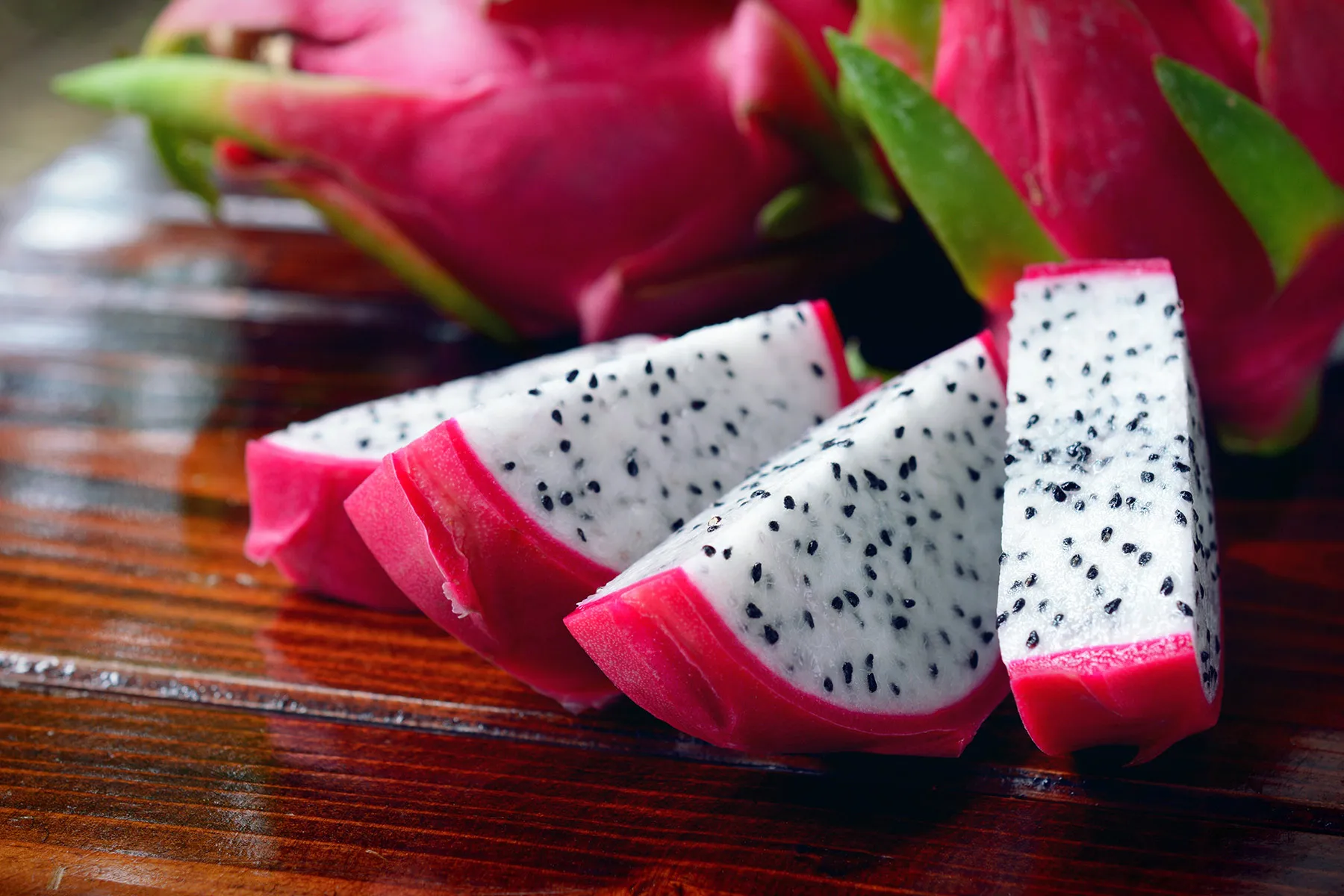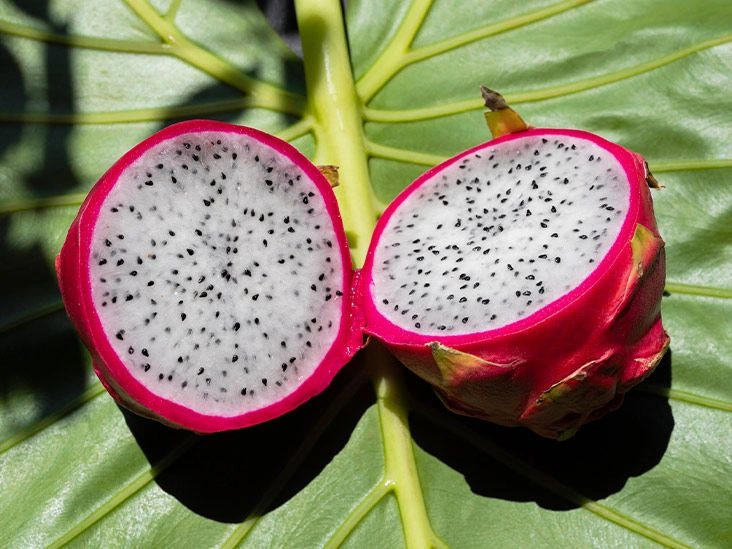Dragon fruit is a tropical fruit that’s low in calories and rich in fiber and antioxidants. Many people describe its flavor as a blend between a pear and a kiwi. You can slice and eat it on its own, pair it with yogurt, or add it to smoothies and salads.
Dragon fruit has gained popularity recently as a tropical favorite.
Although it’s mainly appreciated for its striking appearance and mild flavor, research indicates it might also provide health advantages.
This article examines dragon fruit’s nutrition profile, potential benefits, and simple ways to eat it.

What is dragon fruit?
Dragon fruit grows on the Hylocereus cactus, sometimes called the Honolulu queen; its blossoms open only at night.
The plant originates from southern Mexico and Central America, but it is cultivated worldwide today.
It’s known by several names, including pitaya, pitahaya, and strawberry pear.
The two most typical varieties feature bright red skin with green scale-like tips that resemble a dragon — hence its common name.
The most commonly sold type has white flesh studded with black seeds, though a red-fleshed variety with black seeds is also available but less common.
A different variety often called yellow dragon fruit has yellow skin and white flesh with black seeds.
Despite its exotic looks, the flavor is similar to other fruits. It’s often described as a mildly sweet hybrid of kiwi and pear.
Nutrition facts
Dragon fruit provides modest amounts of various nutrients and is a decent source of iron, magnesium, and dietary fiber.
Nutrition information for a 3.5-ounce (100-gram) serving:
- Calories: 57
- Protein: 0.36 grams
- Fat: 0.14 grams
- Carbs: 15 grams
- Fiber: 3 grams
- Vitamin C: 5% of the DV
- Iron: 1% of the DV
- Magnesium: 2% of the DV
Contains several antioxidants
Dragon fruit harbors a variety of antioxidants.
Antioxidants help shield cells from unstable molecules known as free radicals, which are implicated in aging and chronic diseases.
Key antioxidants found in dragon fruit pulp include (3):
- Betalains: Present in red dragon fruit pulp, these deep red pigments have been shown to lower total cholesterol, LDL, and several other cardiovascular risk markers.
- Hydroxycinnamates: This family of compounds has exhibited anticancer activity in laboratory and animal experiments.
- Flavonoids: A broad, diverse category of antioxidants associated with improved brain health and a lower risk of heart disease (, 7).
One comparison of antioxidant properties across 17 tropical fruits and berries found that, while dragon fruit wasn’t the highest in overall antioxidant capacity, it excelled at protecting certain fatty acids from free radical harm.
Possible health benefits
Animal research indicates dragon fruit may offer multiple health benefits.
Many of these effects likely stem from its fiber and antioxidant constituents.
Both red- and white-fleshed varieties have been reported to reduce insulin resistance and liver fat in obese mice.
In a particular study, mice fed a high-fat diet that received a dragon fruit extract gained less weight and showed reduced liver fat, improved insulin sensitivity, and less inflammation — changes partly attributed to favorable shifts in gut microbiota.
Dragon fruit supplies prebiotic fibers that encourage growth of beneficial gut bacteria, which may support metabolic health.
Although it might improve some features of metabolic syndrome — a cluster of conditions linked to type 2 diabetes — not all outcomes are uniformly positive.
In a 2014 mouse study on a high-fat, high-carbohydrate diet, animals given dragon fruit juice showed better blood glucose responses and improvements in some liver enzyme markers, while another liver enzyme marker rose significantly.
In an earlier trial, diabetic rats treated with a dragon fruit extract experienced a 35% drop in malondialdehyde, a marker of oxidative damage, and decreased arterial stiffness compared with controls.
Human studies on dragon fruit’s effects on type 2 diabetes are mixed, and additional research is necessary to confirm these potential benefits.
Adverse effects
Overall, dragon fruit appears safe for most people, though rare allergic reactions have been reported.
In two older case reports, women without prior food allergies experienced anaphylactic reactions after consuming a fruit blend containing dragon fruit; blood tests later revealed antibodies to dragon fruit.
These are currently the only documented allergic incidents, but others could be allergic without recognizing it.
How to eat it
Although it may seem intimidating at first glance, dragon fruit is very simple to prepare and eat.
How to enjoy dragon fruit:
- Choose a ripe fruit with vivid, even-colored skin that yields slightly when pressed.
- Slice the fruit in half lengthwise with a sharp knife.
- Either scoop the flesh out with a spoon or peel off the skin and cut the pulp into bite-sized pieces.
Serving ideas:
- Slice it and enjoy it plain.
- Dice it and top Greek yogurt with it and some chopped nuts.
- Add it to a salad for color and texture.
The bottom line
Dragon fruit is a low-calorie option with less sugar and fewer carbs than many tropical fruits.
It may offer certain health benefits, but more human research is required to substantiate these effects.
All in all, dragon fruit is distinctive, delicious, and a fun way to add variety to your diet.


















Leave a Reply
You must be logged in to post a comment.